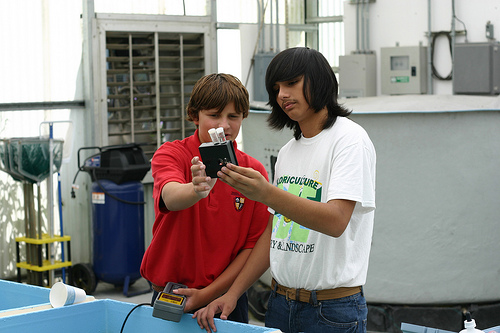
Students use math and chemistry principles learned in the classroom to analyze water quality in growout tanks.
Add middle and high school students to the growing list of Floridians learning about aquaculture, a relatively new industry but one that already generates an estimated $250 million economic impact annually in the state.
In a remarkable 900-square-foot greenhouse on their campus, students at Crystal Lake Middle School in Lakeland are trying their hand at raising tilapia and redfish, using the same methods and facilities found in private farms across the state.
For the present, the students’ goals are not so much financial as academic. Principal Chris Canning believes implementing aquaculture education into his school’s curriculum has helped turn around Crystal Lake’s reputation as a chronic underachiever.
“The aquaculture program has brought about a whole change in the community of kids,” Canning says. “It’s created a lot of excitement. The students work on topics in the classroom, and then they get to go out in a live laboratory and do all of it hands on. It’s really been a wonderful project for both our teachers and our students.”
Canning has used the aquaculture facility as the centerpiece of revitalization efforts at his school that include the creation of the Crystal Academy of Science and Engineering, a magnet program for middle schoolers in Polk County wanting to follow a science or engineering academic path to high school.
By one significant measure, the investment has paid off. In 2010, the state raised the school’s performance grade one full letter, from a C to a B, based on students’ improved scores on the Florida Comprehensive Assessment Test in reading, writing, math and science.
“That’s the first time we’ve broken that barrier,” Canning says. “When I came here, students were flying out of here. Now, a lot of those kids that left one and two years ago are coming back. We have an attractor now. It’s an aquaculture facility that led to an academy setting, where kids that normally wouldn’t come near this place are involved in this school. Parents are involved in this school. And there aren’t two days that go by that a group doesn’t want to come in here and see what we’re doing. This program has put our school on the map.”
Crystal Lake is one of a growing number of Florida schools implementing technology-driven aquaculture programs to provide students with practical applications that reinforce concepts in math, science and even the social sciences. Carlos Martinez, a Florida Sea Grant aquaculture extension specialist with the Institute of Food and Agricultural Sciences at the University of Florida, has helped more than a dozen middle and high schools across Florida implement aquaculture programs. He has provided technical assistance to Crystal Lake’s aquaculture program from the first day.

Crystal Lake Middle Principal Chris Canning, left, talks to Sea Grant aquaculture specialist Carlos Martinez, right, about the successful Teach Aquaculture curriculum.
“When students need to calculate salinity levels in these tanks they need to know how many gallons of water are in that tank, and how much salt is needed to raise it one part, so they’ll use math,” Martinez says as he surveys a row of growout tanks with students at the school. “When we analyze water quality or feed requirements, that brings in chemistry. We talk about country-of-origin labeling on farm-raised fish, and they can learn geography. When we talk about the politics of drilling for oil in the ocean, that covers a lot of social science territory.”
The interest that principals and teachers in Florida have shown aquaculture education is not unique. At a recent national aquaculture conference, educators from many states reported they were teaching aquaculture and aquatic sciences in middle and high schools. What they lacked to make their programs more effective, they said, was some sort of a nationally unified curriculum.
In response, Martinez and a larger team of IFAS extension faculty and curriculum experts have recently written and helped implement “Teach Aquaculture,” a series of instructional modules for middle and high schools that conforms to Florida’s educational standards. Each module, though written at the ninth-grade level, contains activities, supporting materials and assessments adaptable to students as young as kindergartners.
The curriculum is free, and has already been downloaded more than 500 times from its website. Next year, the state’s aquaculture division, which funded the original work, has agreed to fund the UF/IFAS team for an evaluation study that will lead to additional enhancements.
“Teach Aquaculture puts Florida in the lead nationally for aquaculture education in schools,” according to Martinez. “In the short term, it stimulates a student’s interest in learning, but in the long term, it gives a whole new generation the chance to think about aquaculture and marine science as a career.”
Meanwhile, back at Crystal Lake, some may not be thinking much beyond next April. That’s when students involved with the aquaculture facility compete with peers across the state in the annual Florida FFA statewide aquaculture competition. Earlier this year, Crystal Lake surprised even itself, finishing third among six middle school teams, Principal Canning said.
“Our aquaculture program is just three years old, but it’s giving our students the confidence that they can compete with anyone.”
For more information about Teach Aquaculture, contact Martinez, Florida Sea Grant aquaculture specialist Cortney Ohs or e-mail teachaquaculture@gmail.com.



